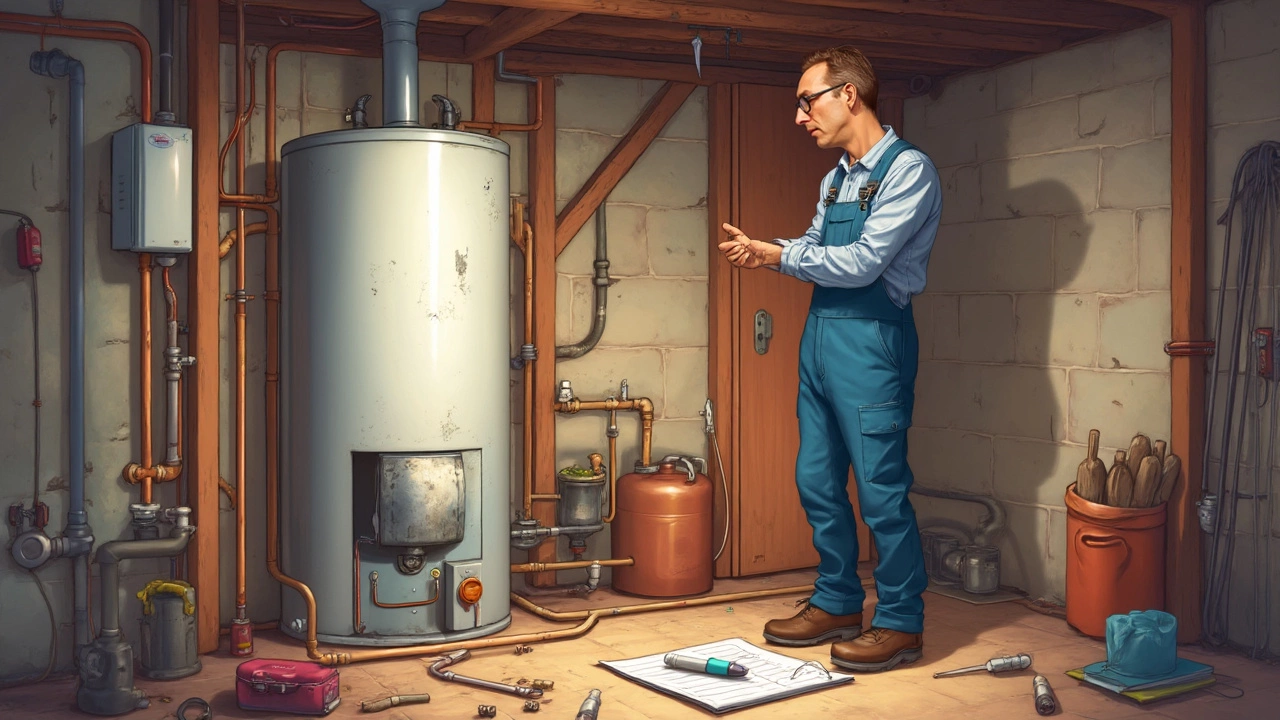You know that low, distant rumble? The one that seems to echo up from your utility room on a quiet night? For most homeowners, that’s just the water heater doing its thing—until it isn’t. When these workhorses finally give out, they do it in the most inconvenient ways. Weird puddles, faint hissing, even a sudden cold shower when you least expect it. Let’s peel back the layers and really check out where most water heaters fail and why those classic breakdowns keep happening.
The Trouble Spots: Where Water Heaters Actually Break Down
If you ask any plumber who’s had to drag boots through a soggy basement, they’ll probably groan about the same main culprit: the tank’s bottom. Most residential water heaters fail right at the bottom of the tank. Here’s the thing—tanks are steel, lined with a glassy coating inside, but that glass inevitably cracks over years of heating and cooling. Water seeps into the cracks, corrosion sneaks in, and eventually the steel rusts through. It often starts as a pinhole, but once that starts, it’s game over for the tank. The leak won’t stop until you shut off the water supply and drain the whole system. It’s not just age either—even tanks just ten years old can give out from this problem, especially in areas with hard water.
Another trouble spot: the connections at the top of the tank. Look up, and you’ll spot the cold water inlet and the hot water outlet pipes. These connections take a beating from heat and movement every day. Over time, the yearly cycles of expansion and shrinking loosen those fittings, especially when paired with cheap installation or constant vibrations from the house’s plumbing. You’ll often find moisture right at those joints, dribbling onto the top of the tank before trickling down.
The drain valve near the bottom—a tiny metal or plastic spigot—is notorious for weak seals or cracking. It seldom leaks the first few years, but loosen it once (say, for a quick flush), and the seal can fail the next season. Repairing these leaks is nearly impossible with a quick fix. Swapping out the valve itself is dicey because you’re usually dealing with mineral-encrusted threads and old, corroded metal.
Don’t forget the pressure relief valve, typically sticking out of one side up top with a pipe running down. This safety device pops open if the system pressure gets dangerously high. But over time, minerals can build up inside it, causing the spring to stick or the rubber seal to degrade. The valve can leak as a warning, but sometimes it just dumps hot water onto the floor unexpectedly. If you ever see water draining from this pipe, don’t ignore it—it’s literally a sign the heater’s under stress.
Oddly, the one part of a water heater designed to corrode is also one that, when overlooked, spells disaster for the whole unit. That’s the anode rod, a metal rod inside the tank designed to attract corrosive minerals. Left untouched for years, the rod dissolves away, leaving the tank exposed. Without it, tank failure is just a matter of time, especially in homes with high mineral content in the water supply.
Finally, the bottom of the tank itself breeds the kind of silent sabotage that most folks ignore—sediment. Sand, silt, and dissolved minerals settle there, baking into a thick, insulating crust. This makes the tank run hotter (to get the same hot water out) and stress the bottom metal plate, speeding up rusting from both outside and within.

Why Do These Failures Happen? Science, Not Bad Luck
It seems almost personal the way water heaters fail, but it’s simple chemistry at work. Water sitting inside metal tanks always finds a way to erode, pit, and rust steel, even with the glass coating that manufacturers put inside each tank. That glass might as well be a windshield—one stray pebble from a dissolved mineral, and you’ve got a micro-crack. Once water gets through, it attacks the steel underneath. The thicker the layer of minerals at the bottom, the hotter that zone runs, which means faster breakdown of the lining and the anode rod.
Speaking of those rods, here’s a curious fact: the average anode rod in a water heater can be used up in just 3-5 years in areas with hard water, yet hardly anyone ever replaces them. Without that rod, the minerals in water go to work on the tank itself. Every time hot water leaves the system, fresh, oxygen-rich water rushes in, ready to restart the corrosion cycle. Some experts even say most tanks could last twice as long with regular anode checks, but who wants to mess with a six-foot-tall hot water jug? That’s why most rods go untouched, and tanks quietly rust out of sight.
Add to this the relentless effects of heat. Think about it: your water heater cycles between room temp and 130°F—maybe up to 140°F for extra sanitation—dozens of times a week. That range of motion isn’t kind to rubber gaskets or threaded metal joints. Expansion and contraction cause micro-movements, unseating gaskets and weakening metal-to-metal bonds at inlets and outlets, especially if the original install was less than perfect.
Mineral build-up is a sneaky enemy, too. According to the U.S. Department of Energy, just one-eighth of an inch of sediment can increase heater energy use by 25%. That same layer holds heat against the bottom panel, baking it well past what the tank was designed for. It’s a slow pressure cooker for rust and corrosion. Add in pH swings from local water chemistry—maybe the town pumped some extra chlorine this year, or maybe the water softener system flaked out—and the tank's inside is a hostile environment that never rests.
Sometimes, tanks even suffer from what’s called “galvanic action.” This happens when dissimilar metals—say, a copper fitting on a steel tank—are connected and submerged in water. Electricity (from the minerals) flows and the less noble metal (often the tank) corrodes much faster. Installers try to use dielectric unions to stop this, but those can be skipped or improperly fitted during a fast install. The more elbows your house has in the plumbing, the more opportunities for this kind of corrosion.
Beyond the materials, simple vibration from your plumbing can worsen tiny leaks around valves and pipes. Ever notice your pipes bang or 'water hammer' when a faucet shuts quickly? That stress is transferred to every joint—including those on your heater. If the tank isn’t anchored well or pipes are rigid against walls, leaks happen sooner rather than later.

How to Spot Failures Early—and Actually Prevent Them
You don’t need to wait for an ankle-deep flood to find out your water heater’s given up. Start with a once-a-month look in your utility room. Get familiar with what dry looks like around your tank. See even a hint of moisture or rust streaks trickling down from the top? That’s your first warning. Wipe it dry and check again in a few days. If dampness returns, a fitting may already be on its way out. Don’t ignore those little white crusty deposits—called efflorescence—they’re signs of slow leaks drying up but leaving traces of minerals behind.
Here’s a tip that almost nobody actually tries: Swap out the anode rod every 3-4 years. Yes, it’s a hassle. Yes, you need a big socket wrench, some elbow grease and possibly a helper, but replacing that single piece of metal can double the lifespan of your tank—especially in places with hard water like Phoenix or Indianapolis. Most home improvement stores sell direct replacements for most major brands.
Consider flushing the tank at least once a year. Drain off a few gallons through the bottom drain valve to remove sediment. If you get cloudy water or bits of grit, keep going until it runs clear. This helps keep the heating element exposed and efficient—especially important if you’ve got an electric unit (those elements get buried in sediment fast).
For those who want extra insurance, cheap leak alarms with moisture sensors can be placed on the floor under or beside the heater. These go off as soon as water is detected, giving you a head start on shutting off the water supply and calling a plumber before things get out of hand. If you’re really trying to stay proactive, hot water heaters with remote monitoring or built-in leak detection are starting to pop up in newer homes.
Watch for hot water that isn’t as hot as it used to be, or water that smells metallic or tastes odd. Either of these can point to anode rod depletion or rust starting to leach into your supply. If you notice unusual popping or rumbling from your tank, it’s usually sediment boiling and shifting at the bottom, another telltale of trapped mineral layers.
Don’t forget to test the pressure relief valve every six months. Just lift the lever and let some water out—make sure it snaps cleanly shut afterward. Water should flow freely for a second and stop when you release the lever. If it dribbles or won’t close, swap it out. New valves cost less than ten bucks, way cheaper than dealing with a burst tank later.
Finally, nothing beats a periodic once-over by a professional. A quick maintenance call can spot corroded connections, bad valve seals, or early anode rod wear before they become huge problems. Some plumbers will even give you rough estimates on years left for your tank, depending on its condition. Not a bad trade for a little peace of mind.
So if you’re hoping to avoid the all-too-common soggy surprise, keep an eye on those classic weak spots: the bottom of the water heater tank, top connection fittings, drain valves, and pressure relief valve. A little attention now saves a whole lot of cleanup (and cash) down the road.

